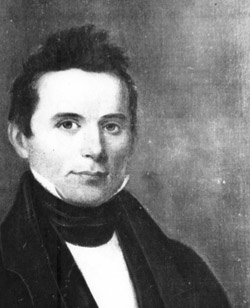Assassinations of “Treaty Party” leaders after the Trail of Tears

Three men had been mainly instrumental in making the treaty of 1835. They were Major Ridge, a full blood Cherokee of the Deer clan, born at Hiwassee in 1771. When still a young man he adopted the manner of living of the white man, mastered their language and became a well-educated man.
This course was at that time very unpopular, as the great mass of the Cherokees were still full Moods and very jealous of their old customs and full blood that would attempt in any way to take up the ways of the backwoods provincials was certain to incur the scorn of his tribesmen. But by sheer force of character, integrity, and worth he gradually forced himself to a high place in the nation. He had been president of the committee and was a major at the Cherokee allies of the Americans in the Creek war of l 8 14. His son, John Ridge, aged about forty years, had been educated in Cornwall. Connecticut, and had returned to the Cherokee nation in 1822. He was a close observer, a brilliant and convincing orator.
The third of this trio was Elias Boudinot, born in 1804. He was the son of Oowatie, the interpretation of whose name was the ancient or revered. Oowatie was a full brother of Major Ridge. Killakeena or Buck (male deer) Oowatie or as they were later known as Watie, while on his way to school at Cornwall, where he attended with his cousin John Ridge, met in Philadelphia, Elias Boudinot of New Jersey, a signer of the national constitution and one of the most prominent men of his day. On account of some favor that he conferred, the boy Buck Watie adopted the name of his benefactor.
Boudinot like his uncle and cousin had early ascended to high places in the councils of the nation and the three men seeing the hopeless condition of their exploited people in the east had made the treaty of 1835 that secured to the Cherokee Nation a splendid home in the west. Men of keen discernment, eloquent and fearless they were publicists to be dreaded.
Before daylight on the morning of Saturday, June 22, the home of John Ridge, near the northwest corner of Arkansas, was surrounded, entered and he was dragged into the yard where two men held his arms while others of their party stabbed him repeatedly and then severed his jugular vein.
A few hours later during the same morning, while his father, Major Ridge, was traveling southward along the Cherokee Nation — Arkansas line road, he was fired on by an ambushed party and killed. This was some twenty-five or thirty miles from the scene of the murder of the son. At about the same time as the killing of Major Ridge, Elias Boudinot was shingling a new house near his residence and within two miles of the residence of Chief John Ross.
Three Cherokees appeared and requested medicine of a sick child of one of the party. Mr. Boudinot had studied medicine so that he could give gratuitous services and medicines to the needy. He started with them to get the required treatment when one of the three stepping behind struck him in the spine with a bowie knife and his groan was the signal for the others to dispatch him with tomahawks. The place of his death was about thirty miles from the murder of Major Ridge and fifty miles from the assassination of John Ridge.
Immediately after his death, Mrs. Boudinot sent word by Rufus McWilliams to Stand Watie and Watie sent his slave, Mike, to inform John Adair Bell, and in this manner, those two escaped mobs that hunted them. Three days later a party that was hunting Stan Watie, searched the house of Rev. Samuel A. Worcester in their quest. Chief Ross notified General Arbuckle on the twenty-second of the killing of Elias Boudinot and that Mrs. Boudinot had informed him that Stan Watie had determined on raising a company of men for the purpose of taking Ross’ life. He further wrote, “I trust that you will deem it expedient forthwith to interpose and prevent the effusion of innocent blood, by executing your authority, in order that an unbiased investigation might be had in the matter.”
General Arbuckle invited Chief Ross to the post at Fort Gibson if he still thought that there was any danger, he also invited Chief Brown. Looney and Rogers to came to the post by the twenty-fifth so that they might concert action to avoid civil strife. Chief Ross on the twenty-third asked that a detachment of troops be sent to protect him.
